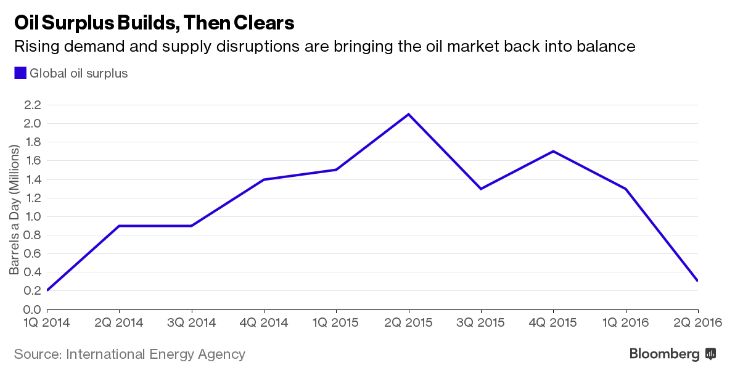The global oil market will be almost balanced next year as demand continues to rise faster than production, while the current oversupply is much smaller than previously thought, the International Energy Agency said.
The surplus in the first half of this year is about 40 percent smaller than estimated a month ago, as consumption proves stronger than expected while disruptions reduce supply, the Paris-based agency said. Still, the “enormous inventory overhang” that accumulated during years of oversupply will limit any significant increase in prices, it said.
“At halfway in 2016 the oil market looks to be balancing,” said the agency, which advises 29 nations on energy policy. “Less oil has been stockpiled than we originally expected” as “oil demand growth has been significantly stronger” and “unexpected supply cuts” strained the availability of crude.
Oil prices in New York have surged about 80 percent from a 12-year low in February to trade near $48 a barrel as production retreats amid investment cuts, wildfires disrupt operations in Canada and militant attacks hit exports from Nigeria. Prices tumbled last year as OPEC refused to concede market share to a crude surplus triggered by years of booming shale oil output from the U.S.
Supplies outpaced consumption by 800,000 barrels a day in the first half of this year, the agency said, having estimated that difference at 1.3 million a day in last month’s report. In the second half, the market will be balanced as a drop in inventories in the third quarter counters another increase in the fourth. The rebalancing of the market may be delayed if halted supplies in Canada, Nigeria and Libya are able to restart, the IEA said.
“Overall, this is another bullish IEA report” that points to “clear light at the end of the tunnel and oil prices well above current levels,” Oswald Clint, a London-based analyst at Sanford C. Bernstein, said in a report.
2017 Outlook
In its first published estimates for supply and demand for 2017, the IEA said that global oil demand will increase by 1.3 million barrels a day next year, the same rate as this year, to reach 97.4 million barrels a day.
Production outside the Organization of Petroleum Exporting Countries will grow by a “modest” 200,000 barrels a day, with gains limited to Canada and Brazil. While U.S. shale oil production will start to recover by the middle of next year, average output for 2017 will be 190,000 barrels a day lower, after falling 500,000 a day in 2016. Global inventories will decline by 100,000 barrels a day through the year, the IEA said.
As growth in demand exceeds non-OPEC supply, more crude will be required from OPEC. The organization will need to provide an average of 33.4 million barrels a day next year, about 800,000 a day more than the 32.6 million a day its 13 members pumped in May, according to the report. Iran, now the fastest-growing OPEC member as it restores exports curbed by international sanctions, may boost output by 100,000 barrels a day next year to 3.7 million a day.
For 2016, the agency raised forecasts for global oil demand by 100,000 barrels a day on stronger U.S. fuel use and cut projections for non-OPEC supply by the same amount. Global oil supplies suffered their first “significant” contraction last month since 2013, falling 590,000 barrels a day from a year earlier as a result of spending curbs and unplanned outages.
India is the “world’s growth leader,” the agency said. Consumption in the second half of 2016 is projected to grow 8.3 percent from the same period a year earlier, while China’s demand will rise 3.3 percent. Indian oil demand is projected to exceed that of Japan this year.
Source: Bloomberg
